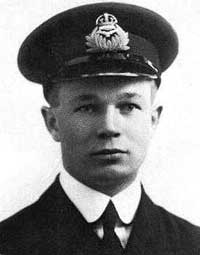 Arthur Roy Brown was born Dec. 23, 1893 in Carleton Place, 30 miles west
of Ottawa, Ontario. Many sources give his name as Royal Brown
but this is not correct according to his daughter, who has his
birth certificate. He was a physical youth enjoying hockey in
particular. He was educated in Carleton Place, but did not do
well in high school and took a year off. He convinced his well-off
folks to send him for his final high school year to his uncle
and aunt in Edmonton to attend Victoria High School from 1913-1915.
There he did much better in school and played hockey so well that
he was offered a position with a junior team.
Arthur Roy Brown was born Dec. 23, 1893 in Carleton Place, 30 miles west
of Ottawa, Ontario. Many sources give his name as Royal Brown
but this is not correct according to his daughter, who has his
birth certificate. He was a physical youth enjoying hockey in
particular. He was educated in Carleton Place, but did not do
well in high school and took a year off. He convinced his well-off
folks to send him for his final high school year to his uncle
and aunt in Edmonton to attend Victoria High School from 1913-1915.
There he did much better in school and played hockey so well that
he was offered a position with a junior team.
As a young man he was shy and intellectual, and suffered from a nagging ulcer. He was not an obvious candidate to be a fighter pilot, except for one thing, he loved flying. As a young man Roy was fascinated with flying. As soon as he finished high school in Edmonton he convinced his parents to send him to Dayton, Ohio to the Wright Brothers flying school. He had to sign papers absolving the Wright Brothers if he was injured or killed while flying one of their light-weight planes, in many ways not much different from the micro-light planes of today. The lessons were expensive, roughly $400 in 1915 but his folks were well off and could afford it. Eventually he got a pilots license (ACA Certificate number 361), this could be after only 8 or so hours in the air, with perhaps half of those solo flying. When WWI started Roy Brown was one of a handful of Canadians ever to fly an airplane.
He joined the Royal Naval Air Service in Canada, as they were paying higher wages for certified pilots than was the Royal Flying Corps. He was appointed a Probationary Flight Sub-Lieutenant in Ottawa, 15 November 1915. He sailed from New York on 2 December 1915 for England. Once there the flying instructors decided he needed more experience so he went to the flying school at Chingford. Disaster struck when he crashed an AVRO 504 in May 1916. He was hauled unconscious from the wreck moments before it burst into flames. His back was broken and he had to spend three months in hospital. It was a long time before he was walking without either a cane or a back brace. In September, 1916 he was posted to the Eastchurch Gunnery School and then to Cranwell in January 1917 to complete advanced training.
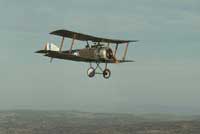 By March, 1917 he talked his way into an active posting with 9 Naval
Squadron and began to fly patrols along the Belgian coast in a
Sopwith Triplane. The standard duties were to locate German seaplanes,
escort bombing missions and watch for Zeppelins returning to their
bases. Much to his dismay he was stricken ill until May when he
was posted to 11 Naval, then to 4 Naval Squadron. Then he was
reposted to 11 Naval Squadron and spent yet another week off sick.
At this time 11 Naval were flying the agile, if underpowered Sopwith
Pup.
By March, 1917 he talked his way into an active posting with 9 Naval
Squadron and began to fly patrols along the Belgian coast in a
Sopwith Triplane. The standard duties were to locate German seaplanes,
escort bombing missions and watch for Zeppelins returning to their
bases. Much to his dismay he was stricken ill until May when he
was posted to 11 Naval, then to 4 Naval Squadron. Then he was
reposted to 11 Naval Squadron and spent yet another week off sick.
At this time 11 Naval were flying the agile, if underpowered Sopwith
Pup.
His first kill came in July when he spotted an Albatros DIII below him. He quickly whipped the agile Pup around and dove on the Albatros, firing from 50 yards. He killed the pilot and the plane fell out of control. To Brown it was only part of the job, a distasteful part. He did not take to showing off or bragging about his kills. To him it was a grisly business, not sport as many pilots made it out to be. He concentrated on downing the machine, and preferred not to think about the man in it.
Brown's squadron was posted to the Western Front to assist the RFC in the terrible air battles of the summer of 1917. The brutal style of continuous fighting, with numerous flights and dogfights a day was a rude awakening to the RNAS pilots, who had had a relatively sedate air war compared to the RFC. A new pilot on the Western Front lasted on average 11 days. Once they had survived a month, they were old hands. This may be the reason why pilots such as Richthofen, Collishaw and Bishop were able to rack up the incredible number of kills they did. Many of their kills were of inexperienced pilots who were relatively easy to shoot down.
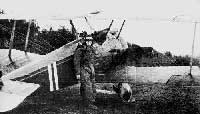 They were also provided with one of the premiere fighter aircraft of
the late war, the Sopwith Camel. This little fighter aircraft
killed more pilots than did the Germans as it was highly unstable
and difficult to fly.
They were also provided with one of the premiere fighter aircraft of
the late war, the Sopwith Camel. This little fighter aircraft
killed more pilots than did the Germans as it was highly unstable
and difficult to fly.
Brown demonstrated his flying expertise by easily outmanoeuvring an Aviatik 2-seater and shooting it down. Before September was out he shot down two more Germans (a DFW C type and an Albatros DV) bringing his total to four Out-Of-Control.
In October he rejoined 9 Naval in the Ostend area where he shot down another two aircraft. On October 6 he was awarded the Distinguished Service Cross for his victories and for an extraordinary act of courage. In the midst of a large dogfight he had to break off with both of his Camel's guns jammed. Being an experienced pilot he kept an eye out for enemies "on his 6", and noticed a single Allied pilot trying to fend off four Albatroses. Brown whipped his Camel around, and still with jammed guns, flew through the Germans, forcing them to scatter and giving the British pilot a chance to escape.
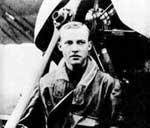 Then his school friend Wilfrid "Wop" May was posted to 209 Sqdn. He
was an extroverted party-goer, who arrived two days late for duty
due to an extended bash. The squadron commander was furious and
ordered May back to England. May asked Brown if he could do anything
for him, he didn't want to be shamed into returning to England
without fighting in the war. The Major relented only if Brown
would take May in his flight.
Then his school friend Wilfrid "Wop" May was posted to 209 Sqdn. He
was an extroverted party-goer, who arrived two days late for duty
due to an extended bash. The squadron commander was furious and
ordered May back to England. May asked Brown if he could do anything
for him, he didn't want to be shamed into returning to England
without fighting in the war. The Major relented only if Brown
would take May in his flight.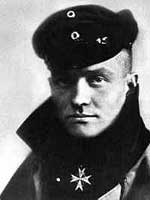 It was little better at Cappy Aerodrome 45 miles away for the Germans
of Jagdstaffel 11, Baron Manfred von Richthofen's Flying Circus.
They too were continually cold, wet, stressed out and exhausted.
They flew because Richthofen flew. He was 25 and close to being
a burned out shell having fought continuously since 1914. He had
survived a serious head wound the previous year, and his young
cousin Wolfram had just joined the famous Jasta 11.
It was little better at Cappy Aerodrome 45 miles away for the Germans
of Jagdstaffel 11, Baron Manfred von Richthofen's Flying Circus.
They too were continually cold, wet, stressed out and exhausted.
They flew because Richthofen flew. He was 25 and close to being
a burned out shell having fought continuously since 1914. He had
survived a serious head wound the previous year, and his young
cousin Wolfram had just joined the famous Jasta 11.